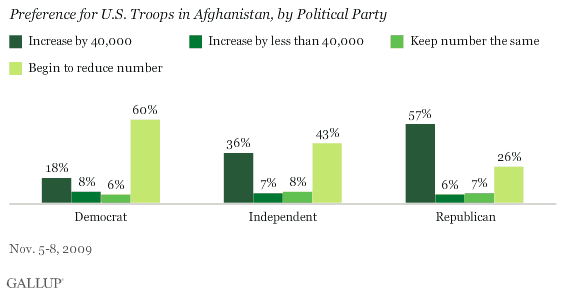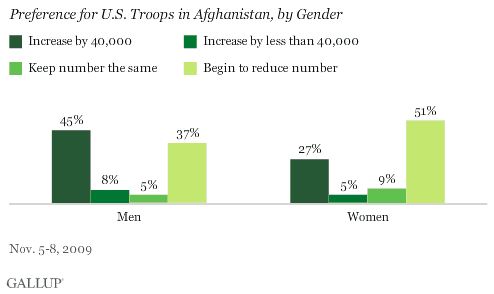PRINCETON, NJ -- As President Barack Obama prepares to make a decision on U.S. military policy in Afghanistan, 35% of Americans say he should follow the recommendation of the commanding U.S. general in Afghanistan and increase troop levels by about 40,000. Another 7% support a smaller troop increase, meaning a total of 42% of Americans support a troop increase of some size. However, nearly the same percentage, 44%, would like to see the number of U.S. troops in Afghanistan reduced.

"If Obama decides to increase U.S. troop levels in Afghanistan, he will be going against the wishes of the vast majority of rank-and-file Democrats."
Obama met with his national security team on Wednesday to further discuss the future U.S. strategy in Afghanistan and what resources the U.S. will need to accomplish its goals. Earlier this year, Gen. Stanley McChrystal, the U.S. commander in Afghanistan, recommended an increase of roughly 40,000 U.S. troops. Media reports suggest the Obama administration is leaning toward an increase in U.S. troops, but by a smaller amount than McChrystal has recommended.
With 44% of Americans in the Nov. 5-8 poll favoring a troop reduction and 7% wanting to keep troop levels where they are, a slim majority appears to oppose a troop increase. Last month, using a different question wording, Gallup also found the public largely divided on sending more troops to Afghanistan.
If Obama decides to increase U.S. troop levels in Afghanistan, he will be going against the wishes of the vast majority of rank-and-file Democrats. In fact, 60% of Democrats would like the president to begin to reduce troop levels in Afghanistan, while 26% support a troop increase of about 40,000 (18%) or less than that number (8%).
On the other hand, the majority of Republicans side with Gen. McChrystal's recommendation and support an increase of about 40,000 U.S. troops, with an additional 6% of Republicans favoring a smaller troop increase.
Independents are evenly divided between favoring a troop increase of any size (36% would like Obama to follow McChrystal's recommended increase and 7% favor a smaller increase) and supporting a reduction in U.S. troops (43%).

Men are much more likely than women to favor expanding the U.S. military operation in Afghanistan. A majority of men favor a troop increase (including 45% who believe Obama should follow McChrystal's recommendation) while only 32% of women agree. A majority of women would like to see the U.S. reduce its troop presence in Afghanistan.

This is not merely because women are more likely to identify as Democrats and men as Republicans, since the gender difference is apparent even when party affiliation is controlled for. Gallup has commonly found men more likely than women to favor military action.
Bottom Line
President Obama's decision on U.S. military policy in Afghanistan is arguably one of the most important of his first year in office. The decision has taken on added political drama as Obama does not appear inclined to go along with the commanding general's recommendation or the wishes of his party's supporters.
At this point, Obama would not appear to have the public's backing if he, as rumored, increases the number of U.S. troops in Afghanistan, since a slim majority would prefer that the president begin to draw down the U.S. presence in Afghanistan or keep the status quo. Such a decision would likely meet the approval of Republicans, who favor a troop increase, but not of his fellow Democrats, who are solidly opposed.
Survey Methods
Results are based on telephone interviews with 1,008 national adults, aged 18 and older, conducted Nov. 5-8, 2009. For results based on the total sample of national adults, one can say with 95% confidence that the maximum margin of sampling error is ±4 percentage points.
Interviews are conducted with respondents on land-line telephones (for respondents with a land-line telephone) and cellular phones (for respondents who are cell-phone only).
In addition to sampling error, question wording and practical difficulties in conducting surveys can introduce error or bias into the findings of public opinion polls.
